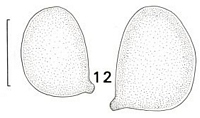|
 Clavaria sp. 1 Clavaria sp. 1
BiostatusPresent in region - Indigenous
Images (click to enlarge)
Caption: Fig. 12 Clavaria Taxon no.1, spores, TENN no. 55773. Scale bar=5µm. |
Article: Petersen, R.H. (1988). The clavarioid fungi of New Zealand. New Zealand Department of Scientific and Industrial Research, Bulletin 236: 170 pp. Wellington:.
Description: Fruit bodies up to 30 x 2 mm, simple clubs, scattered. Stipe up to 12 x 1.5 mm, terete,
somewhat brighter in colour than club, more or less distinct from it, arising at substrate
surface, but without basal mycelial mat. Club terete to somewhat longitudinally sulcate or
flattened, dull light yellow ("buff-yellow"); apex broadly rounded. Taste and odour negligible.
Macro chemical reaction: FCL = negative.
Tramal hyphae of club 2.5-6 µm diam., hardly inflated, clampless, hyaline, of relatively short
cells, parallel, tightly packed. Subhymenium abrupt, rudimentary. Basidia 70-85 x 8-9 µm,
narrowly clavate, clampless, stiff, persistent after spore discharge; contents homogeneous to
granular when mature; sterigmata 4, up to 8 µm long, curved-divergent.
Spores 6.5-7.9 x 4.7-5.8 µm (E= 1.20-1.54; Em = 1.33; Lm = 7.09 µm), ovate to broadly
ovate, somewhat flattened adaxially, hyaline, thin-walled; contents uniguttulate when young
and fresh; hilar appendix broad, papillate; spores collapsing when dried, reviving very
slowly in 2% KOH.
Notes: I have seen only three fruit bodies, insufficient for proposal of a new taxon. Although the
spores are typical of subgenus Clavaria, the basidia are long, narrowly clavate, and stiff, as
are those in subg. Clavulinopsis or those produced by taxa of Ramariopsis subg. Laevispora
(e.g., R. fuciformis or R. corniculata).
So far, one might conclude that, with yellow fruit bodies and the basidia as described, the
taxon might represent a parthenogenetic fruiting of a Clavulinopsis, but the basidia are
strictly tetrasporic, and parthenogenesis is unreported in subg. Clavulinopsis. Studies on nuclear
behaviour in the basidia would be most interesting. Regardless of what the taxon
might represent, it is obviously (and relatively well, except for the basidia) accommodated in
Clavaria subg. Clavaria. There is only the slightest possibility, based on Corner's
(1950: p.254) description, that this may be his C. vermicularis var. singaporensis.
|